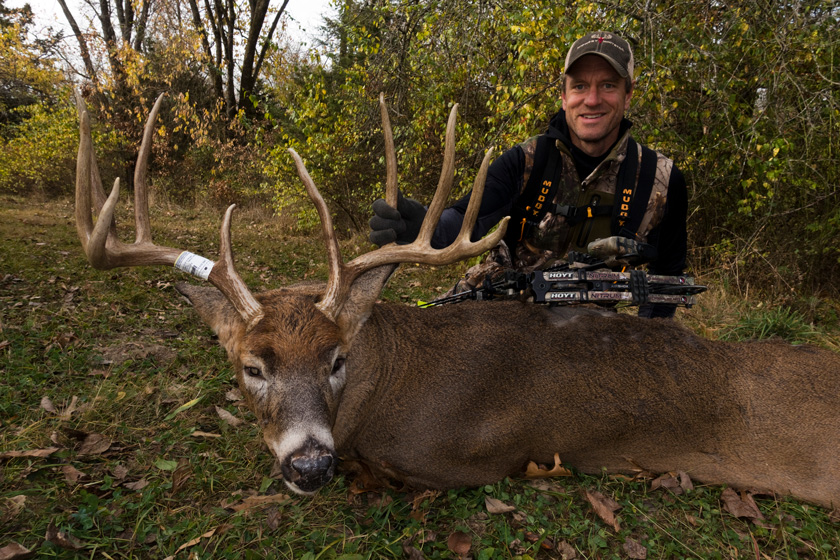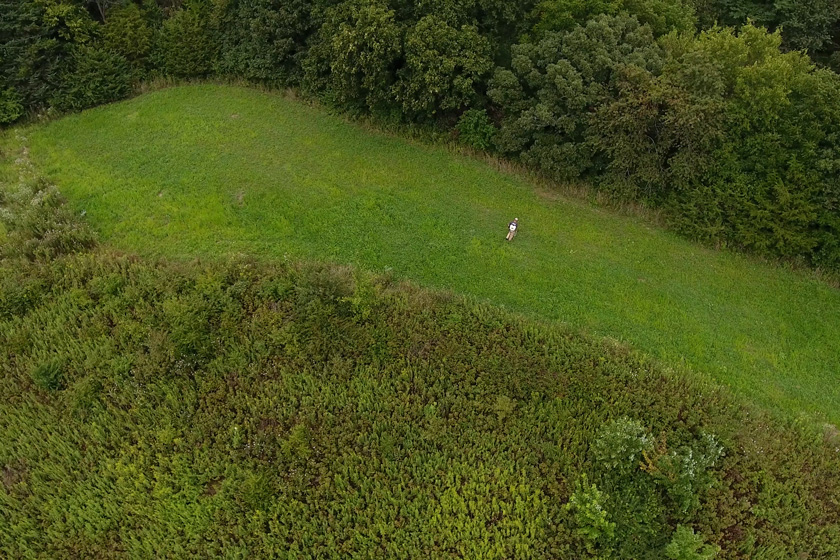
Nearly all the best stand sites on the farm I hunted for 18 seasons were located on the edges of small openings, mostly tiny food plots. When located inside the cover, these small plots offer excellent hunting both morning and evening.
The biggest cause of failure with Poor Man’s Plots is dry conditions so plant as early in the spring as possible to catch at least a few weeks of decent rains before the summer sun bakes the plot. Late April is a great time to plant.
Where To Create It
Clean entry and exit routes are the most important single factor to consider when choosing a location for your efforts. It has to be a spot you can sneak into and out of without any deer knowing that you are, or were, there. That means you need to find a plot site that has an access route that avoids both nearby feeding and bedding areas.

Because the winds usually swirl in low valleys, the best spots for your Poor Man’s Plots are going to be on a ridge or at least on flat land where the wind is stable.
Any natural opening is a great starting point. Further, I like to place my small plots just inside the cover from larger fields whenever I can. This often works well because farmers are no longer able to turn big equipment at the back end of ridges, where they narrow. These areas often grow up to brush that you can hollow out to form your plot.
How to Build a Poor Man’s Plot
My method relies on almost zero power tools (just a chainsaw) to build. You will, however, need some kind of creative way to mow it later. I have even seen guys using old riding lawn mowers.
Making the opening: Cut off any small trees and large brush as close to the ground as possible so you can “farm” right over them.
The perfect size is roughly ¼ to ½ acre — 50 to 75 yards long by 30 to 40 yards wide. Small plots create the best shots with a bow, and if possible, orient any narrow plots east and west, with the path of the sun, to give your plot more hours of sunlight.
Killing the foliage: In a typical site, cutting down everything woody with a chainsaw will still leave lots of thin undergrowth, weeds and grass. A backpack sprayer (about $90) filled with a glyphosate solution will kill all that stuff. Spray everything, but use proper safety measures, especially wearing gloves and a respiratory mask to prevent contact and inhalation.
Plant or wait: If the brush and grass is really thick, or there are lots of leaves on the ground, you will need to remove it so you can get good seed to soil contact when you spread the seed.
If the weeds and grass are light (with very little leaf cover) you can spread the seed, fertilizer and lime right after you spray the herbicide and let the spring rains drive the seed down to the ground as the weeds die.
Wait until everything dies: But, if the ground cover is thick or covered with leaves, you need to burn it off. Wait 10 days to two weeks, until everything is dead and dry. It is doubtful, this small fire will require a permit, but at the very least, notify any nearby residents to avoid an undue visit from the fire department.
Burn it into the wind. If this goes too slowly, you can always move a short way into the plot and burn small stretches with the wind. If you fear that the fire might spread into the woods, you can rake any dry leaves away from the edge of the plot. Discretion is the better part of valor when dealing with fire so have help and be careful. Have a plan and a backup plan!

Fertilizing and liming: A soil test is an important first step when planting any food plot (you can find prepaid soil test pouches online), but you can assume the soil needs help and remedy the condition without a test. Generally, plots found in the timber — or very near the timber — are acidic from the decay of leaves that have fallen on the ground over the years.
As a result, assume that your Poor Man’s Plot is going to need a lot of lime to raise the pH. If you are a real farmer, you know all about spreading bulk lime on your fields to maintain proper pH (normally in the 6.5 to 7.0 range). However, it can be very inconvenient and possibly even impossible to find a good way to spread bulk lime on a small food plot tucked in the woods without access to a tractor and large spreading equipment.
Instead, buy 500 pounds of pelletized lime (per ¼ acre) at a farm and fleet store, lawn and garden store or farm co-op. A walk-behind lime spreader is the best way to spread lime, and is a good investment, but you can also use an over-the-shoulder spreader. You can even use an ATV spreader if you want to move past the true Poor Man’s definition.
Clover is a good first seeding for reasons I will get into in a bit. Clover likes phosphorus (P) and potassium (K) fertilizer. These are central ingredients of the normal fertilizer blends. The third ingredient is nitrogen (N), which clover doesn’t require to grow well.
To keep this simple, tell the person you buy the fertilizer from that you want roughly 15 pounds of actual P and K (for every ¼ acre of plot size). If they don’t know what that means, just get 100 pounds for the ¼-acre plot (200 pounds for the ½-acre plot) of Triple 13 (the nitrogen in that blend is not needed but it may be hard to buy bagged fertilizer that doesn’t have nitrogen in it).
A bag-style over-the-shoulder spreader will do the job, but the same walk-behind spreader you used for the lime would be ideal.
Planting: I already recommended planting a clover blend. Blends are easy to find from good food plot companies and usually come in small portions. They also have enough variety in the mix to tolerate a range of climate and soil conditions.
Clover is pretty easy to establish, pretty easy to maintain and will stand up to deer browsing pressure. Moreover, deer like it and it is good for them. The clover will be a little thin for the establishment year if planted in the spring, but it will be really thick during years two and three. After year three, it is generally a good idea to kill the clover, ideally till it under, and plant something else in its place for a year. A good choice would be a brassica blend (turnips, radishes, etc.).
The same bag-style spreader I had you consider for the fertilizer application (and the lime too) is the best way to disperse your seeds. The most economical model that I have used is the Earthway Ev-N-Spred Model 2750. I recently bought one online for $40.
Set the spreader opening small to start so you don’t over-seed from the beginning. With experience, you can figure out the setting to cover your plots in one pass.
Pray for rain: Now, all that remains is a few good rain showers to get the seeds started and feed the young seedlings for the first critical month or two of their growth.
Maintaining the plot: Three steps will keep your clover plots growing well for three years. You need to mow it each summer — early June is a good target — and you need to keep fertilizing it each winter. The third maintenance requirement depends on the outcome of the planting. Sometimes you have to spray the plot with a grass selective herbicide, which kills the grass but not the clover. If the plot is grassy, this is an important step. You can find basic grass selective herbicides online if you search for them.
That’s it — you are done. If you add up the cost of all the tools, fertilizer and seed, you will see that a ¼-acre Poor Man’s Plot is very reasonable. Once established it will quickly become your favorite hunting spot, and well worth the investment!












